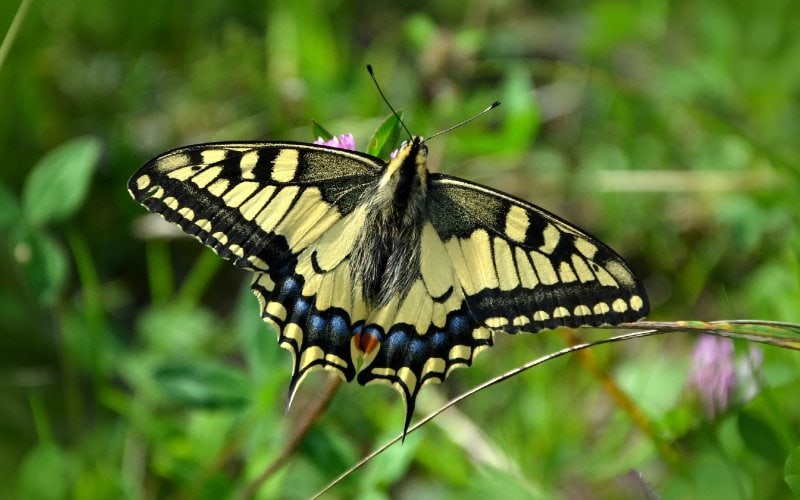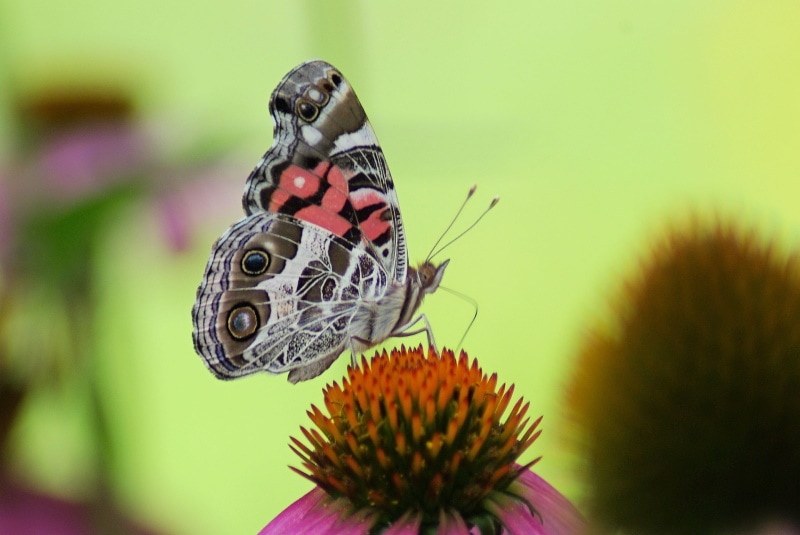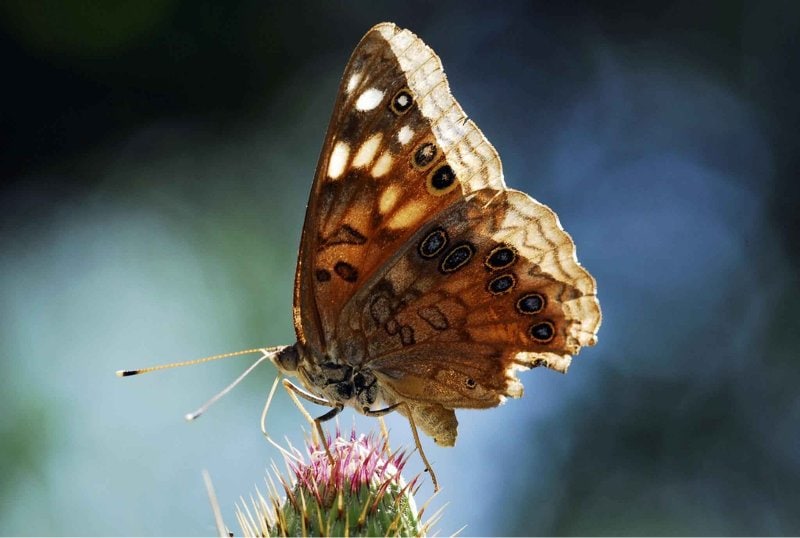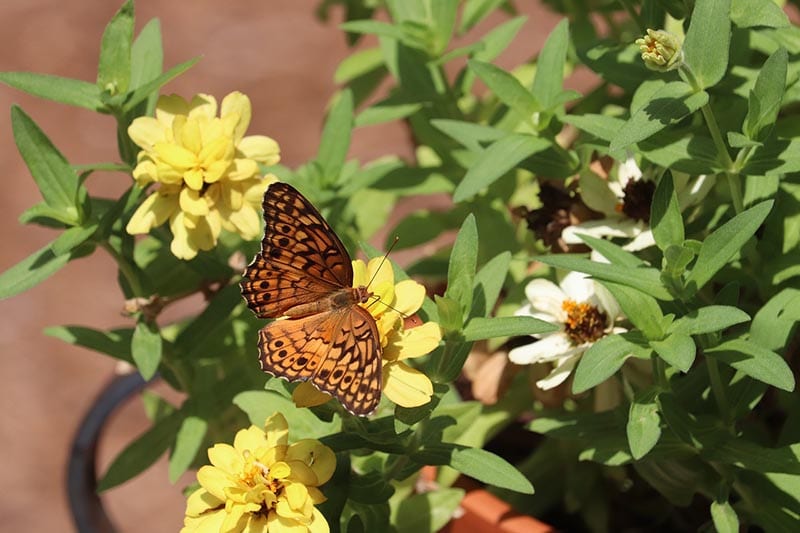15 Most Common Types of Butterflies in Alabama (With Pictures)
-
Misty Layne
- Last updated:

Butterflies are gorgeous, so it’s no wonder people love to watch them flit around. And there are so many types of butterflies in the world. But what about in Alabama? What butterflies call that state home?
If you’re a resident of the state, then you already know there are tons of butterflies to be found in Alabama. It’s a lot! Unfortunately, we can’t tell you about all of them today, but we can tell you about the 15 most common types of butterflies in Alabama.
So, continue reading to learn all about these beautiful insects!
The 15 Most Common Types of Butterflies in Alabama
Admirals, Queens & Emperors
We’ll start with the butterflies considered Admirals, Queens, and Emperors. These particular butterflies have bright colors and are relatively large; they’re also easy to find in Alabama.
1. American Lady

| Scientific Name | Vanessa virginiensis |
| Wingspan | 1.75 to 2.5 in |
| Habitat | Open landscapes with flowering plants |
The American Lady can be recognized by its bright orange coloring. This orange will have darker borders, plus spots in purple and white. The underside of the wings has what is known as “eyespots” (exactly what they sound like—spots that resemble eyes), as well as patterns that look like a spiderweb. The eyespots are used to warn off predators by making the American Lady look intimidating.
This butterfly isn’t intimidating at all, though, and is actually a somewhat nervous insect. It is easily spooked and will take off at the slightest disturbance.
2. Hackberry Emperor

| Scientific Name | Asterocampa celtis |
| Wingspan | 2 to 2.75 in |
| Habitat | Yards, parks, moist areas in woods |
You’ll find the Hackberry Emperor in nearly every county in Alabama, and they are a bit plainer than most with their brown wings. You can identify them by the orangish eyespots near the wing tips, the spots that are a darker brown than the amber brown of the wings, and the few white spots on them.
The Hackberry Emperor is somewhat unusual in that it doesn’t eat flower nectar. Instead, you may find one of these butterflies landing on you if you’re outside and sweaty, as this butterfly will get sodium from your sweat. They’ll even get sodium from soil and rocks. This butterfly will also consume rotten fruit, carrion, and sap.
3. Monarch

| Scientific Name | Danaus plexippus |
| Wingspan | 3.5 to 4 in |
| Habitat | Open and sunny spaces |
Even if you aren’t an Alabama native, you know this butterfly! The Monarch is likely the most well-known butterfly in the United States due to its easily recognizable orange pattern that looks like stained glass and its habit of migration. Besides the stained glass look, you’ll see black veins and white spots on the wings of this butterfly. You’ll most often find the Monarch hanging out near milkweed, as this is the only thing the Monarch caterpillars will eat.
Another thing to know about this butterfly is that it is endangered.
4. Red-Spotted Purple

| Scientific Name | Limenitis arthemis astyanax |
| Wingspan | 3 to 4 in |
| Habitat | Open woods and other open areas |
The Red-Spotted Purple butterfly is one of the most beautiful to be found in the state of Alabama. These butterflies are stunning with iridescent dark blue wings that are black on the bottom and red, orange, or light blue spots on the tips! And they have the coloring they do for a reason—this coloring looks very similar to the Pipevine Swallowtail butterfly, which is poisonous, so it helps the Red-Spotted Purple stay safe.
This is another butterfly that doesn’t consume nectar but instead eats rotten fruit, sap, and carrion.
 Crescents, Commas & Anglewings
Crescents, Commas & Anglewings
The names for these butterflies come from the markings they have on their wings, which can form complex designs.
5. Common Buckeye

| Scientific Name | Junonia coenia |
| Wingspan | 2 to 2.5 in |
| Habitat | Pastures, fields |
Though a bit plain looking, the Common Buckeye is also easy to recognize with its brown color and bars of orange. You’ll also find 3–4 eyespots on this butterfly’s wings with shades of orange, green, or magenta in the middle. These butterflies are cautious of people, but they’ll also often perch low to the ground long enough for you to take a photo.
6. Question Mark

| Scientific Name | Polygonia interrogationis |
| Wingspan | 2.25 to 3 in |
| Habitat | Near forests, wet woodlands |
Question Mark seems like a rather odd name for a butterfly species, but it comes from a marking on the bottom side of their wings that vaguely resembles a question mark. You’ll also be able to tell the Question Mark by its dark orange color edged in dark brown that features black spots. Their coloring helps these butterflies look like dead leaves, which allows them to avoid predators when hanging out on branches.
The Question Mark caterpillars like elm trees and nettle best, so you’ll probably find this butterfly near those.
7. Pearl Crescent

| Scientific Name | Phyciodes tharos |
| Wingspan | 1.25 to 1.75 in |
| Habitat | Open and sunny areas |
Though the Pearl Crescent’s wings have black markings that resemble lace, they also have a tiny crescent-shaped mark on the bottom of their wing in pearl-white that gives them their names. The majority of their wings are orange, though.
The Pearl Crescent is the most common crescent and enjoys the Aster plant above all others. So, if you want to attract this butterfly to your yard, plant a few Asters, and they should show up!
Fritillaries
Fritillaries are butterflies that have patterns on their wings that resemble a checkerboard. Their wing coloring is most often shades of black and orange.
8. Variegated Fritillary

| Scientific Name | Euptoieta claudia |
| Wingspan | 1.75 to 2.25 in |
| Habitat | Fields and meadows |
This butterfly’s wings are anywhere from light brown to dark orange, with patterns of black lines and dots. They also have black lining the edge of their wings. More impressive, though, is the Variegated Fritilarry’s chrysalis—between its pearl white color and gold spikes that shine, it looks more like a pricey piece of jewelry than a chrysalis!
These butterflies are very cautious and nervous, so they can be hard to approach. You also won’t find these guys flying about in large numbers.
Satyrs & Snouts
These aren’t your satyrs of fantasy novels; these are butterflies that enjoy hanging out in cool, shaded areas! The name comes from when they used to be considered the Satyridae family rather than now when they are considered a sub-group of the Nymphalidae family. The Snouts are referred to as thus because they have labial palps that resemble a “snout”.
9. American Snout

| Scientific Name | Libytheana carinenta |
| Wingspan | 1.5 to 2 in |
| Habitat | Deciduous woodlands |
You’ll most likely recognize the American Snout due to its, well, “snout”. It has a unique one, even among Snouts, that is most likely used to make itself look more like a leaf. It also has brown wings with white and orange patches to aid its camouflage.
Other than camouflage, this butterfly uses startle tactics to ward off predators. Just a quick flash of its wings gives a predator a startling burst of orange color to warn it off.
10. Carolina Satyr

| Scientific Name | Hermeuptychia sosybius |
| Wingspan | 1.25 to 1.5 in |
| Habitat | Moist forests |
These little guys are the tiniest of the Satyrs found in Alabama and one of the plainest butterflies as well. Their wings are pretty much entirely a muddy color of brown that only feature an eyespot or two and possibly a few ripples.
This butterfly rarely flies higher than a foot off the ground. Because it spends so much of its life at ground level, it is able to detect vibrations via the veins in its forewings.
11. Little Wood Satyr

| Scientific Name | Megisto cymela |
| Wingspan | 1.5 to 1.9 in |
| Habitat | Brushy areas, shaded woodlands |
The Little Wood Satyr is another Plain Jane butterfly. Like the Carolina Satyr, they are brown but have a series of eyespots near the edge of their wings—two on the top wings and one to three on the bottom wings. They also like to stay closer to the ground, so will hang out on piles of leaves instead of branches.
The Little Wood Satyr also has a rather gross diet. Like a few other butterflies, it doesn’t often consume nectar; instead, it eats old sap, animal dung, carrion, and rotting mushrooms.
Gossamer Wings
This type of butterfly is precisely what it sounds like—one with lovely and, often, brightly colored gossamer wings.
12. Eastern Tailed-Blue

| Scientific Name | Cupido comyntas |
| Wingspan | 0.75 to 1 in |
| Habitat | Gardens, pastures |
When it comes to the Eastern Tailed-Blue, males and females actually have different colors on the upper wings. Females’ wings are gray-brown with white around the edges. Males are a bright blue with white around the edges and a bit of brown. Both females and males will have a couple of tiny orange spots placed right above the tails of the wings.
The simplest way to recognize these butterflies, though, is likely by their hind wings, which contain hair-like tails.
Swallowtails
Swallowtail butterflies have extremely long wing tails, larger than normal wings, and are often found in bright colors.
13. Eastern Tiger Swallowtail

| Scientific Name | Pamilio glaucus |
| Wingspan | 3.5 to 5.5 in |
| Habitat | Deciduous woodlands |
The Eastern Tiger Swallowtail has a few varying looks that are based on the sex of the butterfly. Males will always be bright yellow with black stripes that resemble a tiger. But females can be either light or dark. The light coloration is a dark yellow with black stripes and markings, but the dark coloration is entirely black, except for a bit of light blue on the lower wings.
The Eastern Tiger Swallowtail is fairly solitary, but occasionally, you’ll come across a “puddle club” where a group of males gathers to get water from wet ground.
Fun fact: this butterfly is the state butterfly of Alabama!
Whites & Sulphurs
You guessed it—these small butterflies often come in shades of white! They also don’t have patterns on their wings like other butterfly types.
14. Cabbage White

| Scientific Name | Pieris rapae |
| Wingspan | 1.25 to 2 in |
| Habitat | Sunny areas |
The Cabbage White has light green to white wings, with black on the tips. This species also has black dots on the center of its wings—one dot for males, two for females.
This also isn’t a native Alabama species. Rather the Cabbage White invaded back in 1881 and is now extremely common. Unfortunately, the Cabbage White caterpillars (also known as Cabbage worms) can be highly damaging to crops, as they enjoy kale and cabbage.
15. Cloudless Sulphur

| Scientific Name | Phoebis sennae |
| Wingspan | 2.2 to 2.8 in |
| Habitat | Open areas |
These butterflies are easily recognized due to their bright yellow color, almost the same shade as a lemon. And this species is nearly always only yellow in color, with no patterns (though they might have a couple of markings). Occasionally, you may also find a tiny white eyespot on the upper wings.
Probably the most interesting thing about this butterfly, other than the sunny color, is that the species’ proboscis is extremely long. This enables these butterflies to consume nectar from the same sorts of plants that hummingbirds feed from.
In Conclusion
As you can see, Alabama is home to a host of butterflies. From Whites and Sulphurs to Admirals and Queens, the state has a bit of everything when it comes to these winged insects. And butterflies are so beloved that not only does Alabama have a state butterfly, but the Monarch butterfly is the state insect!
So, next time you’re in Alabama, take a good look around. You’ll most likely see a few different butterflies flitting about!
Featured Image Credit: congerdesign, Pixabay
Contents

 Crescents, Commas & Anglewings
Crescents, Commas & Anglewings